Chris Riley tests the 2024 BYD Seal Premium rear-wheel drive EV with pricing, specs, ride and handling, safety, verdict and everything the over-50 driver needs to know.
Summary: Here’s another new arrival from BYD and one that shows this Chinese company is no flash in the pan. It’s sure to capture a lot of buyers.
2024 BYD Seal EV sedan
Pricing: $58,798 (plus on road costs)
Options: Ocean Blue paintwork $1500
Warranty: Six-years, 150,000 km, battery: eight-years, 160,000km
Safety: 5-star ANCAP (2023)
Engine: electric permanent magnet
Service intervals: 12 months or 20,000km
Power: 230kW
Torque: 360Nm
Transmission: CVT auto, rear wheel drive
Body: 4800mm (long); 1875mm (wide); 1460mm (high)
Build country: China
Kerb weight: 2055kg
Towing capacity: 1500kg
Luggage storage: 400L (rear), 50L (front)
Wheels: 19-inch alloy
Tyres: 235/45R19 Continental EcoConti
Spare wheel: tyre repair kit
Ground clearance: 145mm
Turning circle: 11.4m
Battery: 82.56kWh
Claimed range: 650km (NEDC), 570km (WLTP)
Charging time: 27 hours (standard power point)
Consumption: 12.7kWh/100km)
Consumption on test: 15.7kWh/100km (Eco mode, 455km)
seniordriveraus consumption on test: not tested
[review]
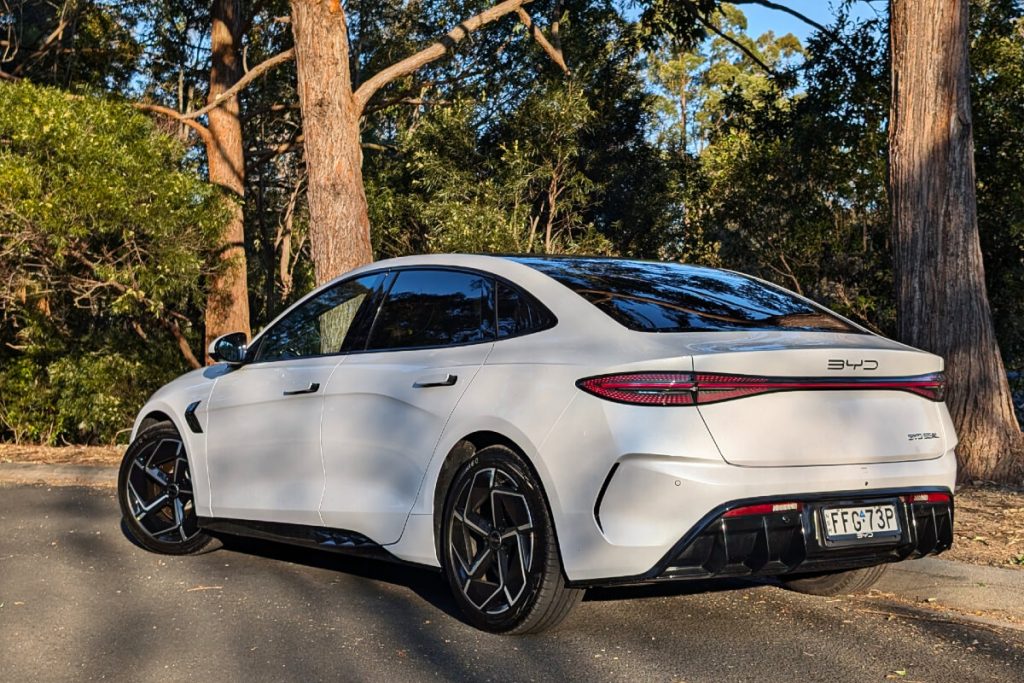
There’s no mistaking the BYD Seal for its smaller sibling the Dolphin.
The electric sedan is a good-looking car by any standard, with movie-star looks for a surprisingly small outlay.
And the more you learn about the Seal, the more interesting it becomes. We kept waiting for the catch, but it never arrived.
BYD hasn’t sold buyers short like some of the Chinese brands, by leaving out essentials such as satnav and Android Auto.
So if you’ve had your eye on a Tesla Model 3, then you’ll want to take a long, hard look at this one before parting with your money.
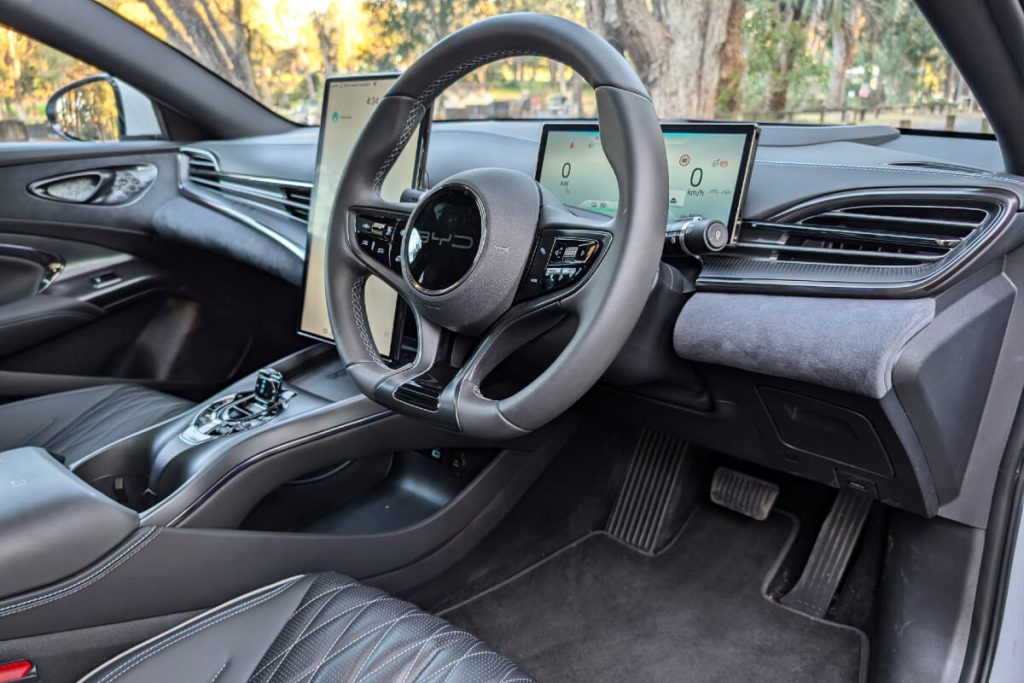
What’s it cost?
There are three grades from which to choose: Dynamic RWD, priced from $49,888, Premium RWD from $58,798 and Performance AWD from $68,798.
The colour Ocean Blue adds $1500 to the price.
Our test vehicle was the mid-range Premium rear-wheel drive version with the larger battery.
Like the Dolphin, the Seal is part of BYD’s Ocean series and supposedly features many water-inspired design features, although we’re not quite sure what apart from the wavy pattern on the dash air vents.
The exterior adopts a contemporary coupe design with a long bonnet, sloping roofline, pop-out door handles and full-width LED strip across the back. It boasts a super slippery drag coefficient of just 0.219 Cd.
This car is light years from Australia’s first fully electric vehicle, Mitsubishi’s funny little i-MIEV hatch, which made its debut here way back in 2010.
The biggest single factor in picking the Premium is its extended range, which rises from 460 to 570km – that’s better than some conventional cars.
The more expensive Performance variant might be quicker, but pays a price for that performance with a reduced range of 520km.
Range is everything when it comes to EVs.
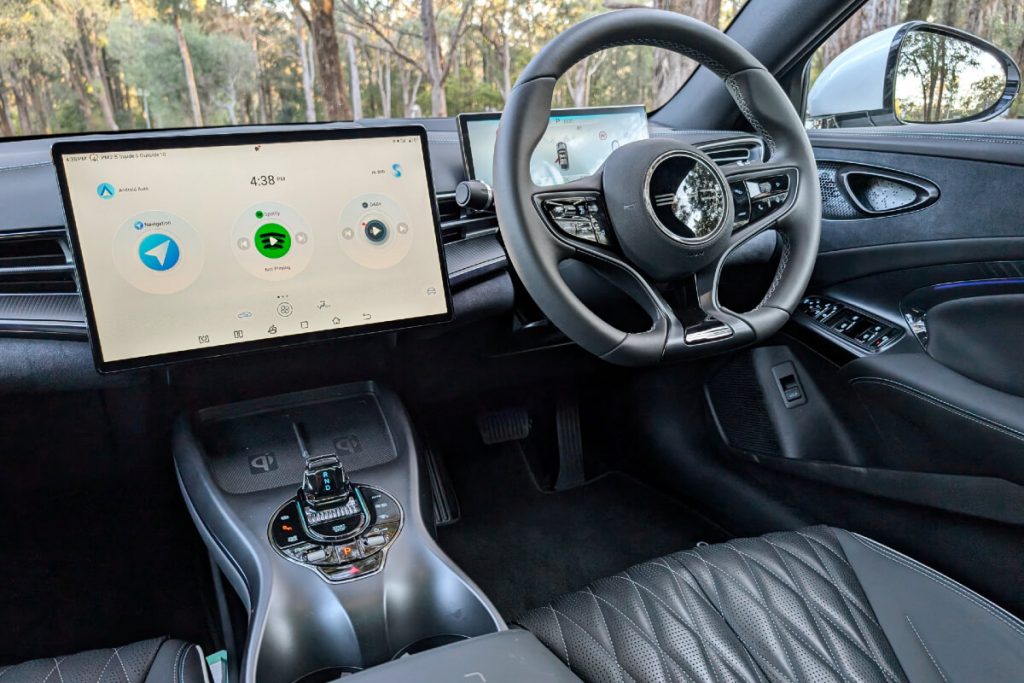
The standard model gets 18-inch alloys, keyless entry and start, artificial leather, dual zone climate air, heated and cooled front seats, eight-way power adjust driver seat and four-way power adjust passenger seat, with auto retract for ease entry and exit.
There’s also a full-length glass roof, power boot lid, 10.25-inch digital instrument panel, soundproof windows and privacy glass, adaptive cruise control, LED lights with auto high beam, traffic sign recognition, auto lights and wipers and an auto dimming rear view mirror, 360-degree rear view camera, plus front and rear parking sensors.
Premium steps up to 19-inch wheels, better Continental rubber, real quilted leather, with driver seat memory and power lumbar adjustment for the driver, plus head-up display and auto tilt exterior mirrors.
Infotainment in all three is controlled from a huge 15.6-inch touchscreen that dominates the dashboard and rotates at the push of a button.
No prizes for guessing which competitor this is aimed at.
There’s also Bluetooth, voice activation, AM/FM and DAB+ digital radio, built-in satellite navigation, built-in 4G connection, wired Apple CarPlay and wireless Android Auto, 128GB of on-board storage plus a 12-speaker Dynaudio audio system.
NFC allows you to lock and unlock your car with your phone, while a smartphone app allows drivers to connect with the Seal, with features such as charge status, aircon pre-conditioning, remote locking/unlocking and remote control of the lights and horn.
There are six different display themes, but the light themes are too washed out to see stuff clearly in sunlight and the dark option is too muddy to see some things at all.
USB-C and USB-A ports are provided in the front, with another set in the back, with wireless charging in the front for two phones.
Five-star safety extends to nine airbags, including a centre airbag, which provides added protection to front seat occupants in side impact crashes, as well as autonomous emergency braking (car-to-car, vulnerable road user, junction and crossing, backover and head-on).
Lane support comes with lane keep assist, lane departure warning and emergency lane keeping, a speed assist system and speed sign recognition.
There’s also front and rear cross-traffic alert with auto braking.
Seal is covered by a six-year 150,000km warranty, with an additional two years and 10,000km on the battery.
Servicing is due every 12 months or 20,000km.

What’s it go like?
The BYD Seal sits long and low, with a short boot and long bonnet and pop-out door handles.
The low height and sloping roofline could make getting in and out an issue, depending on age and/or agility.
But once you’re inside it’s nice and snug, with an upmarket feel and plenty of legroom front and back plus rear air vents.
It’s pretty quiet inside too which makes for easy conversation between the front and back.
The full-length glass roof is heavily tinted but lacks a screen of any kind which does not bode well for the Australian summer.
A power-operated boot lid hides a deep but shallow 400-litre storage area, with a hidey-hole underneath to store the charge cable.
A note of warning because after opening the boot the lid dropped about 25cm unexpectedly as we ducked under it to retrieve something, with the car parked on a slope.
There’s another 50 litres of storage available under the front bonnet.
A tyre repair kit is supplied in the event of a flat tyre.
Head-up display keeps your eyes on the road ahead, at least that’s the idea.
On the other hand, the sloping roofline and smallish rear windows restrict over the shoulder vision.
It’s also difficult to judge the extremities of the car, but front and rear parking sensors and a 360-degree birds-eye camera help when it comes to parking.

The huge 15.6-inch touchscreen is as large as the screen on this Chromebook and rotates at the push of a button, but becomes invisible to polarised sunglasses in the vertical position.
Android Auto will not run with it in the vertical position either.
To start the car, put your foot on the brake, push the start-stop button, toggle forward or reverse using the tiny transparent selector and you’re good to go.
Our first stint behind the wheel of the Seal was cut short however because someone had forgotten to charge the car, with only 127km of range showing.
But we were comforted by the fact that it was only 68 easy kilometres down the motorway back home, which left 60km in the tank to play with, so to speak.
By the time we got back, however, things were looking grim with just 20km left.
Not sure what happened to the other 40 kays, but many factors influence EV range including hills, speed and the aircon.
With an 82.56 kWh battery, the test car is supposed to have a range of 570km under the WLTP standard, with claimed energy consumption of 16.6 kWh/100km.
The charge port is located at the rear and on the driver’s side of the car.
Charging at home using a standard power point can take up to 27 hours, but the car is not supplied with a home charge cable.
Using a public AC charger, with charging capped at a rate of 7kW, a full charge takes something like 12 hours which is overly long.
A 150kW DC fast charger, if you can find one, takes as little as 30 minutes to get to 80 percent.
But too much fast charging can ruin your battery.
There’s a bank of Tesla superchargers not too far from here, but for non-Tesla users they are cost prohibitive.
The first and last time we used a Tesla charger was at Bathurst where we had to stump up 85 cents per kWh.
Our nearest charge station, an AC charger, took just over 16 hours to do the job and cost $46 at a rate of 51 cents per kWh.
However, here’s the weird thing… the battery took 90.2kW according to Exploren which is greater than its actual capacity – how can that be?
Further investigation revealed that charging paused at some point during the process and power was siphoned off for cooling.
EVs! The more you learn, the more there is to know.
Along with range, the other major factor likely to influence your buying decision is performance.
Dynamic and Premium grades get a single electric motor that produces 230kW of power and 360Nm of torque, with drive to the rear wheels through a single speed automatic transmission.
Top spec Performance adds a second electric motor that boosts total output to 390kW and 670Nm, with drive to all four wheels.
Dynamic does the dash to 100km/h in a creditable 7.5 seconds, Premium in a sharp 5.9 seconds and Performance in a sizzling 3.8 seconds.
The top speed of all three is capped at 180km/h.
Seal is BYD’s second offering here, built on BYD’s e-Platform 3.0 and with 800-volt architecture.
The ‘blade’ battery pack is positioned under the car as part of the chassis which gives it higher torsional rigidity and contributes to a lower centre of gravity, with improved ride and handling as a result.
This shows on the road where the Seal sits low and scythes through the air, thumping gently over bumps with a big car feel.
Acceleration is rapid, it’s super quiet inside and, with double-wishbone suspension, ride quality is surprisingly good.
Coarse bitumen can generate quite a bit of road noise.
My wife complained the steering was too sharp for her liking, but like most aspects of the car, it can be adjusted.
There are three levels of regenerative charging, but even at the maximum level it’s hardly intrusive.
One-pedal driving which does away with the need to brake is not offered.
With a fully charged battery, Eco mode selected and a range of 650km indicated, we hit the road to Wollongong south of Sydney where we spent the night before returning.
The car indicated 360km of range remaining on our return.
No need for range anxiety.
Rated at 16.6kWh/100km, we were getting a long-term average of 15.7kWh/100km after 455km in Eco mode.
Moreover, with a full charge the range seems more resilient and does not disappear as quickly as some EVs that we have driven.
That’s comforting to know.
On a final note, the satnav system keeps warning of speed cameras that are simply not there (and never had been for that matter).
Somehow it would seem mobile cameras have found their way into the system as permanent ones.
Better safe than sorry I suppose.
What we like
- Eye-catching looks
- Satisfying performance
- Range to match a conventional car
What we don’t like
- Wired CarPlay
- Bogus camera warnings
- Odd warranty
What over-50s need to know
BYD Seal is an impressive car and one of the better EVs that we have driven.
With a range of 570km it has what it takes to go head-to-head with petrol-powered vehicles and could change the way you feel about electric cars.
The main issue for mature drivers will be the low ride height, sloping roofline and perhaps the difficulty that presents getting in and out.
Some fine tuning of the driver-assist systems is necessary, but so it is with most of the cars we test these days.
However, BYD would be well served to align its warranty with the seven years/unlimited kilometres industry benchmark and ditch the penny-pinching exclusions.
Competitors include the likes of Tesla Model 3, Polestar 2, Volvo C40 Recharge and Kia EV6, along with the Hyundai Ioniq 5 and Ioniq 6.
You don’t get much for the price from Tesla while the Volvo and Polestar are more expensive, which leaves the Kia and Hyundai pair as the most likely contenders.
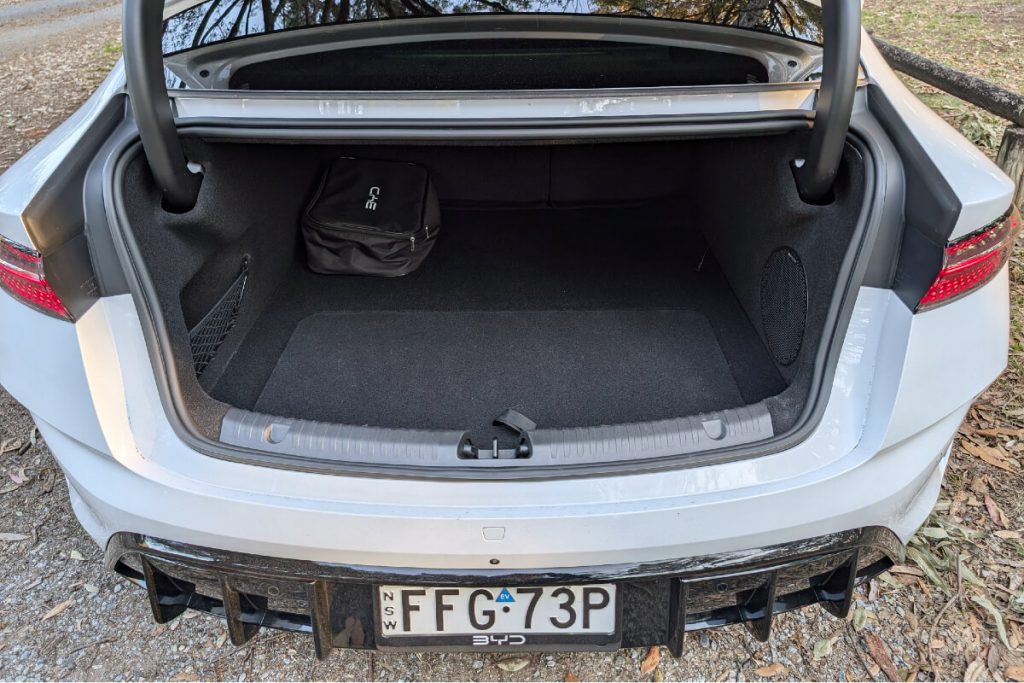
seniordriver comments
Here’s another BYD EV at a (relatively) affordable entry price. And the range is comparable to many ICE cars.
Tough luck if you’re using an Apple phone, because you’ll have to connect it using a cable, even though Android can operate wirelessly.
As usual, you’ll pay a penalty for the swoopy styling – the roofline can make entry and exit a bit of a challenge, especially if your mobility is restricted. Try it before you make the final decision.
We’re not sure why Chris keeps getting electric cars without a home charging cable. It’s never happened to seniordriveraus. In fact, since we’ve had so much trouble linking in to any of the electricity suppliers, it’s just as well!
As for the sat nav picking up phantom speed cameras, that’s another thing we don’t understand. However, better to pick up some that don’t exist than miss those that do.
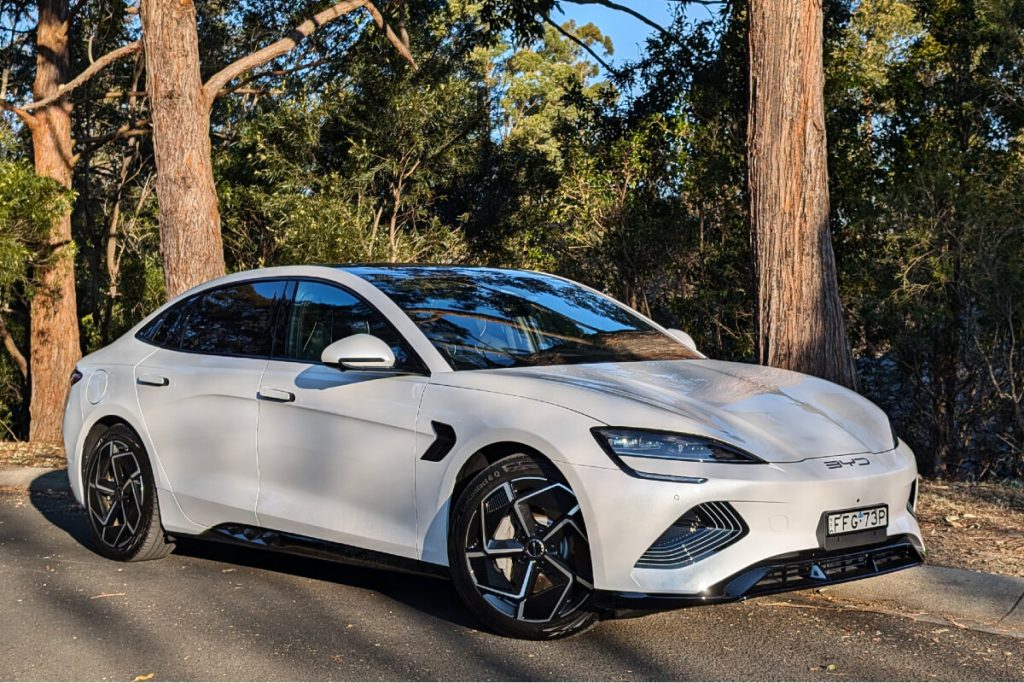
The BYD Seal is a good-looking car (with hints of Porsche about it), but its ride and handling could do with some attention. BYD has said it wants to be the number one brand in Australia by 2030 (an ambitious target) but with cars like the Seal, we can see it happening. BYD has already proven its chops with the Atto 3 and the recently arrived (and even more affordable) Dolphin.

